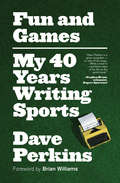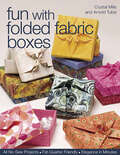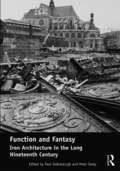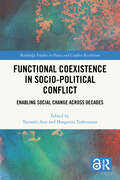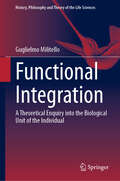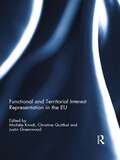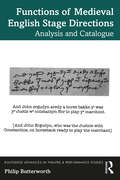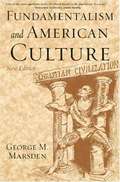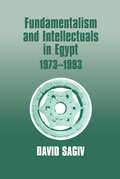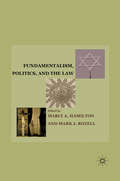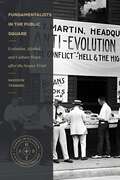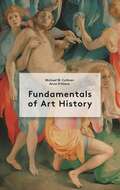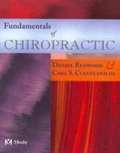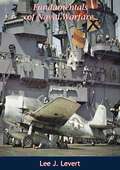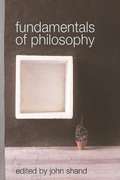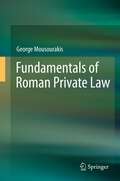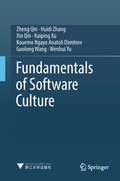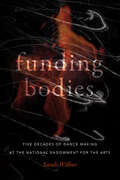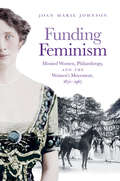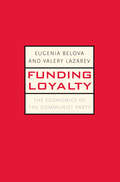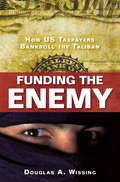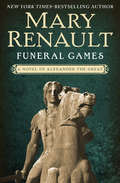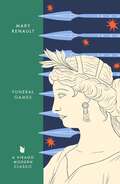- Table View
- List View
Fun and Games: My 40 Years Writing Sports
by Dave Perkins&“Covering many of the biggest names and greatest events in sports, it&’s a wonderful collection of yarns and reminiscences, told in Perk&’s inimitable style&” (Postmedia News). Dave Perkins was once told by a bluntly helpful university admissions officer: &“You don&’t have the looks for TV or the voice for radio. You should go into print.&” Which he did, first at the Globe and Mail, and then for thirty-six well-traveled years at the Toronto Star. In Fun and Games, Perkins recounts hysterical, revealing, and sometimes embarrassing personal stories from almost every sport and many major championships. After forty years of encountering a myriad of athletes, fans, team managers, and owners, Perkins offers unique observations on the Blue Jays and Raptors, fifty-eight major championships&’ worth of golf, ten Olympic Games, football, hockey, boxing, horse racing, and more. Learn why Tiger Woods asked Perkins if he was nuts, why he detected Forrest Gump in the 1996 Atlanta Olympics, and why Super Bowl week is the worst week of the year. Perkins exposes the mistakes he made in both thought and word—once, when intending to type &“the shot ran down the goalie&’s leg,&” he used an &“i&” instead of an &“o&”—and to this day, he has never found a sacred cow that didn&’t deserve a barbecue. &“Few can spin a yarn with the wit and clever turns of phrase that Perky can.&” —Shi Davidi, Sportsnet &“Anyone who has ever spoken to Dave Perkins, or read Dave Perkins, remembers his voice. This book is a delightful way to experience it all again, through the wise, funny man&’s eyes.&” —Bruce Arthur, Toronto Star sports columnist
Fun with Folded Fabric Boxes: All No-Sew Projects, Fat-Quarter Friendly, Elegance in Minutes
by Crystal Mills Arnold TubisA Bounty of Boxes to Fashion From Fabric & Paper. Quick and easy no-sew techniques for making beautiful origami boxes with our easy-to-follow how-to illustrations and photos. Make in a variety of sizes-and have fun embellishing them! There is no limit to the ways you can use these impressive boxes: pretty storage, home decor accents, gift boxes, party favors...Inspired by a traditional folded Japanese box (masu), the boxes can be funky, lavish, or elegant depending on the materials you choose. Perfect for fat quarters or those special papers you've been saving. Includes lots of embellishment ideas.
Function and Fantasy: Iron Architecture In The Long Nineteenth Century
by Paul Dobraszczyk Peter SealyThe introduction of iron – and later steel – construction and decoration transformed architecture in the nineteenth century. While the structural employment of iron has been a frequent subject of study, this book re-directs scholarly scrutiny on its place in the aesthetics of architecture in the long nineteenth century. Together, its eleven unique and original chapters chart – for the first time – the global reach of iron’s architectural reception, from the first debates on how iron could be incorporated into architecture’s traditional aesthetics to the modernist cleaving of its structural and ornamental roles. The book is divided into three sections. Formations considers the rising tension between the desire to translate traditional architectural motifs into iron and the nascent feeling that iron buildings were themselves creating an entirely new field of aesthetic expression. Exchanges charts the commercial and cultural interactions that took place between British iron foundries and clients in far-flung locations such as Argentina, Jamaica, Nigeria and Australia. Expressing colonial control as well as local agency, iron buildings struck a balance between pre-fabricated functionalism and a desire to convey beauty, value and often exoticism through ornament. Transformations looks at the place of the aesthetics of iron architecture in the late nineteenth and early twentieth centuries, a period in which iron ornament sought to harmonize wide social ambitions while offering the tantalizing possibility that iron architecture as a whole could transform the fundamental meanings of ornament. Taken together, these chapters call for a re-evaluation of modernism’s supposedly rationalist interest in nineteenth-century iron structures, one that has potentially radical implications for the recent ornamental turn in contemporary architecture.
Functional Coexistence in Socio-Political Conflict: Enabling Social Change Across Decades (Routledge Studies in Peace and Conflict Resolution)
by Tatsushi Arai Margarita TadevosyanThis book introduces the concept of functional coexistence as a context for building practical strategies for long-term conflict intervention and social change.Functional coexistence is a pragmatic relationship of mutual non-recognition sustained in the absence of physical violence. In this volume, a team of internationally recognized scholar-practitioners of peacebuilding presents seven in-depth case studies of functional coexistence, expanding its potential for practical conflict intervention. Bridging theory to evidence and vision to practice, the book offers guideposts for sustained conflict intervention, presents compelling examples of peace potential within the context of functional coexistence, and identifies common pathways for change among them. It also proposes a customized framework for program evaluation and highlights the merit of long-term policymaking and funding. Instead of losing hope based on traditional expectations of conflict resolution and reconciliation, this pioneering study of conflict non-resolution demonstrates the power of tenacious pragmatism, strategically guided by a decades-long historical view of social change.This book will be of interest to students of conflict resolution, peacebuilding, international relations, foreign policy, and security studies.The Open Access version of this book, available at http://www.taylorfrancis.com, has been made available under a Creative Commons Attribution-Non Commercial-No Derivatives (CC-BY-NC-ND) 4.0 license.
Functional Integration: A Theoretical Enquiry into the Biological Unit of the Individual (History, Philosophy and Theory of the Life Sciences #38)
by Guglielmo MilitelloThis book explores the main biological dimensions underlying functional integration and examines how they contribute to defining a biological individual as both a physiological and evolutionary unit. Functional integration lies at the heart of most definitions of both organisms and biological individuals, making it explanatorily relevant to biology as well as to the philosophy of biology. However, the notion—typically referring to any causal interdependence among biological functions—remains broad and lacks a coherent theoretical framework. This work addresses that gap by focusing on functional integration at the cellular level, which presents both a minimal degree of complexity (relative to multicellular organisms) and maximal conceptual significance for this inquiry. By analysing the transition from prokaryotes to eukaryotes, the book sheds light on how spatial constraints, system-level regulatory mechanisms, spatio-temporal coordination, and system-level reproduction contribute to characterizing biological organization as a functionally integrated physiological unit. This study opens the way for a fresh reflection on the foundations of biological individuality, offering insights not only for researchers, but also for students and non-specialist readers.
Functional and Territorial Interest Representation in the EU (Journal Of European Integration Special Issues Ser.)
by Justin Greenwood Christine Quittkat MichDespite a substantial legacy of literature on EU interest representation, there is no systematic analysis available on whether a European model of interest representation in EU governance is detectable across functional, and territorial, categories of actors. ‘Functional’ actors include associations for business interests, the professions, and trade unions, as well as ‘NGOs’ and social movements; territorial based entities include public actors (such as regional and local government), as well as actors primarily organised at territorial level. What are the similarities and differences between territorial, and functional, based entities, and are the similarities greater than the differences? Are the differences sufficient to justify the use of different analytical tools? Are the differences within these categories more significant than those across them? Is there a ‘professionalised European lobbying class’ across all actor types? Does national embeddedness make a difference? Which factors explain the success of actors to participate in European governance? This book was originally published as special issue of Journal of European Integration.
Functions of Medieval English Stage Directions: Analysis and Catalogue (Routledge Advances in Theatre & Performance Studies)
by Philip ButterworthWhen we speak of theatre, we think we know what a stage direction is: we tend to think of it as an authorial requirement, devised to be complementary to the spoken text and directed at those who put on a play as to what, when, where, how or why a moment, action or its staging should be completed. This is the general understanding to condition a theatrical convention known as the 'stage direction'. As such, we recognise that the stage direction is directed towards actors, directors, designers, and any others who have a part to play in the practical realisation of the play. And perhaps we think that this has always been the case. However, the term 'stage direction' is not a medieval one, nor does an English medieval equivalent term exist to codify the functions contained in extraneous manuscript notes, requirements, directions or records. The medieval English stage direction does not generally function in this way: it mainly exists as an observed record of earlier performance. There are examples of other functions, but even they are not directed at players or those involved in creating performance. More than 2000 stage directions from 40 or so plays and cycles have been included in the catalogue of the volume, and over 400 of those have been selected for analysis throughout the work. The purpose of this research is to examine the theatrical functions of medieval English stage directions as records of earlier performance. Examples of such functions are largely taken from outdoor scriptural plays. This book will be of great interest to students and scholars in theatre, medieval history and literature.
Fundamentalism and American Culture (2nd edition)
by George M. MarsdenMany Americans today are taking note of the strong political force that is the religious right. Controversial decisions by the government are met with hundreds of lobbyists, millions of dollars of advertising spending, and a grassroots response.
Fundamentalism and Intellectuals in Egypt, 1973-1993
by David SagivThis study examines the attitude of Egyptian intellectuals towards Islamic fundamentalism in Egypt. They believe that to establish an Islamic state would mean a return to the Middle Ages and that Western values do not necessarily contradict Islam. How far can they influence Egypt's future?
Fundamentalism, Politics, and the Law
by Marci A. Hamilton Mark J. RozellThis book studies the phenomenon of fundamentalism in the United States. It contains historical and contemporary scholarly analysis of the Christian movements that emerged around the time of the Moral Majority.
Fundamentalists in the Public Square: Evolution, Alcohol, and Culture Wars after the Scopes Trial (Studies in Historical and Systematic Theology)
by Madison TrammelA myth-busting work on fundamentalists and culture The Scopes Trial of 1925 is often regarded as a turning point in the history of American fundamentalism and evangelicalism. It is claimed that Scopes was a public relations defeat that sent fundamentalism into retreat from mainstream culture. In Fundamentalists in the Public Square: Evolution, Alcohol, and the Culture Wars after the Scopes Trial, Madison Trammel argues that such a characterization is misguided. Using documentary evidence from newspapers in the 1920s and 1930s, Trammel shows that fundamentalists remained fully active in seeking to transform the culture for Christ, and they remained so through the rise of Billy Graham's ministry. Grounded in historical evidence, Fundamentalists in the Public Square offers a fresh take on the relationship between fundamentalism, evangelicalism, and the public square.
Fundamentals of Art History
by Michael Cothren Anne D'AllevaThis invaluable guide enables students to get the most from their art history course. Written in an accessible style, the book introduces two basic art historical methods - formal analysis and contextual analysis. In this new edition revising author Michael Cothren has extended the discussion on iconography and iconology, as well as adding discussions on the effects of the market and museums on art. Greater emphasis is placed on the global and multicultural aspects of art creation and analysis with new images and more case studies. There is more step-by-step guidance on how to use these methods to prepare for exams and write papers.
Fundamentals of Art History
by Michael Cothren Anne D'AllevaThis invaluable guide enables students to get the most from their art history course. Written in an accessible style, the book introduces two basic art historical methods - formal analysis and contextual analysis. In this new edition revising author Michael Cothren has extended the discussion on iconography and iconology, as well as adding discussions on the effects of the market and museums on art. Greater emphasis is placed on the global and multicultural aspects of art creation and analysis with new images and more case studies. There is more step-by-step guidance on how to use these methods to prepare for exams and write papers.
Fundamentals of Chiropractic
by Marc Micozzi Daniel Redwood Carl S. ClevelandThis textbook introduces and explains basic chiropractic philosophy and history, principles, and applications in practice. In addition to covering chiropractic care techniques, it also discusses anatomy, biomechanics, and physiology, as well as spinal analysis and diagnostic procedures. Key scientific and philosophical issues within the chiropractic community are addressed. Clearly presented material in an easy-to-follow format defines unfamiliar terms, explains and illustrates concepts, and reinforces ideas through review and critical thinking questions. The book's broad scope and discussions of diverse topics make it ideal for students or anyone in the chiropractic community. Topics and content parallel the test plan outlines from the National Board of Chiropractic Examiners, ensuring that all material is relevant, up-to-date, and accurate. Well-known chapter contributors - some of the most respected and influential names in the field - give the book a balanced approach, reflecting the diversity within the profession on issues related to the science and philosophy of chiropractic. Well-referenced discussions include the most up-to-date research. Key terms and critical thinking/review questions in each chapter familiarize the reader with important concepts and promote a solid understanding of the material.
Fundamentals of Naval Warfare
by Lee J. Levert William T. BradyAn outline of the principles and methods of naval warfare, comprehensive and excellently organized, this book will interest the general public as well as naval personnel.Intended for the general reader, Fundamentals of Naval Warfare is a plea for better understanding of the facts about naval warfare in order to support security measures. Ships and bases need trained personnel—the cost of unpreparedness is high. Here is a summary of the history of war, of weapons, of ships, of battles. Here is a discussion of the tactics of shore installations, base planning, harbor defense, employment in naval warfare, amphibious warfare, engineering problems, staff work, logistics, etc.Lieutenant-Commander Lee J. Levert carefully avoids any implication of personal bias, speaking only rarely of specific officers. He presents sample problems in planning and execution of plans to illustrate his points. He feels we have reached the twilight of carriers, as such, and presents the ideal ship-a combination of a battleship and a carrier, in one.Fundamentals of Naval Warfare is primarily a book for students of strategy and tactics, of naval warfare—and for armchair admirals.
Fundamentals of Philosophy
by John ShandFundamentals of Philosophy is a comprehensive and accessible introduction to philosophy. Based on the well-known series of the same name, this textbook brings together specially commissioned articles by leading philosophers of philosophy's key topics.Each chapter provides an authoritative overview of topics commonly taught at undergraduate level, focusing on the major issues that typically arise when studying the subject. Discussions are up to date and written in an engaging manner so as to provide students with the core building blocks of their degree course. Fundamentals of Philosophy is an ideal starting point for those coming to philosophy for the first time and will be a useful complement to the primary texts studied at undergraduate level. Ideally suited to novice philosophy students, it will also be of interest to those in related subjects across the humanities and social sciences.
Fundamentals of Political Economy
by George C. WangA book about the Cultural Revolution that began in China in 1966 and continued till 1976, and the restoration of capitalism after the death of Mao Tse-tung.
Fundamentals of Roman Private Law
by George MousourakisRoman law forms a vital part of the intellectual background of many legal systems currently in force in Continental Europe, Latin America, East Asia and other parts of the world. Knowledge of Roman law, therefore, constitutes an essential component of a sound legal education as well as the education of the student of history. This book begins with a historical introduction, which traces the evolution of Roman law from the earliest period of Roman history up to and including Justinian's codification in the sixth century AD. Then follows an exposition of the principal institutions of Roman private law: the body of rules and principles relating to individuals in Roman society and regulating their personal and proprietary relationships. In this part of the book special attention is given to the Roman law of things, which forged the foundations for much of the modern law of property and obligations in European legal systems. Combining a law specialist's informed perspective with a historical and cultural focus, the book provides an accessible source of reference for students and researchers in many diverse fields of legal and historical learning.
Fundamentals of Software Culture
by Zheng Qin Huidi Zhang Xin Qin Kaiping Xu Kouemo Ngayo Dimitrov Guolong Wang Wenhui YuAs the first book about software culture, this book discusses software culture from three perspectives including historical perspective, the classification of software and software applications. This book takes credit from the view of science and technology development. It analyzed scientific innovations and the social areas promoted following the growth of technology. And according to the fact that information helps to build human cultural form, we proposed the concept and researching method of software culture. The aim of writing this book is to strengthen the connection between software and culture, to replenish knowledge system in the subject of software engineering, and to establish a new area of study that is the culture of software.
Funding Bodies: Five Decades of Dance Making at the National Endowment for the Arts
by Sarah WilburFive Decades of Dance Making at the National Endowment for the Arts
Funding Feminism: Monied Women, Philanthropy, and the Women’s Movement, 1870–1967 (Gender and American Culture)
by Joan Marie JohnsonJoan Marie Johnson examines an understudied dimension of women's history in the United States: how a group of affluent white women from the late nineteenth through the mid-twentieth centuries advanced the status of all women through acts of philanthropy. This cadre of activists included Phoebe Hearst, the mother of William Randolph Hearst; Grace Dodge, granddaughter of Wall Street "Merchant Prince" William Earle Dodge; and Ava Belmont, who married into the Vanderbilt family fortune. Motivated by their own experiences with sexism, and focusing on women's need for economic independence, these benefactors sought to expand women's access to higher education, promote suffrage, and champion reproductive rights, as well as to provide assistance to working-class women. In a time when women still wielded limited political power, philanthropy was perhaps the most potent tool they had. But even as these wealthy women exercised considerable influence, their activism had significant limits. As Johnson argues, restrictions tied to their giving engendered resentment and jeopardized efforts to establish coalitions across racial and class lines. As the struggle for full economic and political power and self-determination for women continues today, this history reveals how generous women helped shape the movement. And Johnson shows us that tensions over wealth and power that persist in the modern movement have deep historical roots.
Funding Loyalty
by Eugenia Belova Valery LazarevThe flow of money to national, regional, and local Soviet communist party organizations, the manner in which money was collected, and how their financial discipline was enforced all yield deep insights into the party’s role in the Soviet institutional design. Funding Loyaltyexamines the Soviet communist party's financial operations and its budget from the 1930s through 1960s, providing a fresh look at the evolution of the party and its role in the Soviet economy and society as a whole.
Funding the Enemy
by Douglas A. WissingWith the vague intention of winning hearts and minds in Afghanistan, the US government has mismanaged billions of development and logistics dollars, bolstered the drug trade, and dumped untold millions into Taliban hands. That is the sobering message of this scathing critique of our war effort in Afghanistan. According to this book, America has already lost the war. While conducting extensive research and fieldwork in Afghanistan's war zones, a drumbeat of off-the-record and offhand remarks pointed the author to one conclusion: "We blew it." The sentiment was even blazoned across a US military fortification, as the author saw at Forward Operating Base Mehtar Lam in insurgency-wracked Laghman Province: "I glanced over at a concrete blast barrier while waiting for a helicopter," Wissing says. "Someone had spray-painted in jagged letters: 'The GAME. You Lost It.'" The author's vivid narrative takes the reader down to ground level in frontline Afghanistan. It draws on the voices of hundreds of combat soldiers, ordinary Afghans, private contractors, aid workers, international consultants, and government officials. From these contacts it became glaringly clear, as the author details, that American taxpayer dollars have been flowing into Taliban coffers, courtesy of scandalously mismanaged US development and counterinsurgency programs, with calamitous military and social consequences. This is the first book to detail the toxic embrace of American policymakers and careerists, Afghan kleptocrats, and the opportunistic Taliban. The result? US taxpayers have been footing the bill for both sides of a disastrous Afghanistan war.
Funeral Games: A Novel Of Alexander The Great: A Virago Modern Classic (The Novels of Alexander the Great #3)
by Mary RenaultThe conclusion to the New York Times–bestselling trilogy of ancient Greece by the author Hilary Mantel calls &“a shining light.&” By the end of his reign, Alexander the Great had seized control of an empire that extended from the Adriatic Sea to the Indus River. When he died in 323 BC, a fervent scramble for power ensued. Funeral Games is Mary Renault&’s remarkable novel of this turmoil and the gradual erosion of the Greek empire. The power players include Ptolemy, two father-son teams, and a cadre of influential women—not least of whom is Eurydike, whose plan is to marry Alexander&’s disabled brother, Arridaios. Brimming with outsize personalities, brazen plots, and a sweeping sense of history, Funeral Games brings to vivid life the world of Alexander the Great, and the seismic tumult in the wake of his death.Funeral Games is the final volume of the Novels of Alexander the Great trilogy, which begins with The Persian Boy and Fire from Heaven.This ebook features an illustrated biography of Mary Renault including rare images of the author. &“Mary Renault is a shining light to both historical novelists and their readers. She does not pretend the past is like the present, or that the people of ancient Greece were just like us. She shows us their strangeness; discerning, sure-footed, challenging our values, piquing our curiosity, she leads us through an alien landscape that moves and delights us.&” —Hilary Mantel
Funeral Games: A Novel of Alexander the Great: A Virago Modern Classic (Virago Modern Classics #317)
by Mary Renault'The Alexander Trilogy contains some of Renault's finest writing. Lyrical, wise, compelling: the novels are a wonderful imaginative feat' SARAH WATERSIn the final novel of her stunning trilogy, Mary Renault vividly imagines the life of Alexander the Great, the charismatic leader whose drive and ambition created a legend.Alexander the Great died at the age of thirty-three, leaving behind an empire that stretched from Greece and Egypt to India. After Alexander's death in 323 B.C. his only direct heirs were two unborn sons and a simpleton half-brother. Every long-simmering faction exploded into the vacuum of power. Wives, distant relatives and generals all vied for the loyalty of the increasingly undisciplined Macedonian army. Most failed and were killed in the attempt. For no one possessed the leadership to keep the great empire from crumbling. But Alexander's legend endured to spread into worlds he had seen only in dreams.'Mary Renault is a shining light to both historical novelists and their readers. She does not pretend the past is like the present, or that the people of ancient Greece were just like us. She shows us their strangeness; discerning, sure-footed, challenging our values, piquing our curiosity, she leads us through an alien landscape that moves and delights us' - HILARY MANTEL'The Alexander Trilogy stands as one of the most important works of fiction in the 20th century . . . it represents the pinnacle of [Renault's] career . . . Renault's skill is in immersing us in their world, drawing us into its strangeness, its violence and beauty. It's a literary conjuring trick like all historical fiction - it can only ever be an approximation of the truth. But in Renault's hands, the trick is so convincing and passionately conjured' Antonia Senior, The Times
